On Thursday 9th February, CuSP attended the Alliance for Sustainable Building Products (ASBP) Healthy Buildings Conference.
The event offered a diverse line-up of speakers from leading research institutions across the built environment and construction sectors. Topics included material toxicity and fire, post occupancy evaluation and insurance of mass timber buildings.
We attended the session which discussed “Can sustainability be compatible with fire safety?”, which was hosted by Professor Richard Hull from the University of Central Lancashire Centre for Fire and Hazards Science.
It was a very informative session with some shocking information on the fire safety of buildings. Here are our key learnings.
Fire retardants
Richard began the session by introducing fire retardants and the potential toxic hazards from them. Fire retardants were introduced following the widespread availability of cheap plastics and they allow these cheap plastics to be used in high-risk situations.
Fire retardants are optimised to pass regulatory tests however they don’t actually always make the product safer, as certain types make smoke much more toxic. For example, fire retardant (or its decomposition products) is toxic when released during a fire and it also increases the toxicity of the fire effluent.
Grenfell Tower
One example that Richard provided of material toxicity and fire is the Grenfell Tower disaster. The PIR (Polyisocyanurate) foam insulation that was used in the cladding of the building is much more toxic than other foams yet, shockingly, there is no regulation which states that materials which are toxic when they burn shouldn’t be used on the side of buildings.
Just last month, it was revealed that up to a dozen firefighters who tackled the blaze at Grenfell Tower have been diagnosed with terminal cancer and it isn’t difficult to see why when you consider the toxic chemicals that were released from the burning plastic insulation.
Cancer incidence amongst fire fighters
With Grenfell Tower in mind, Richard provided insights into a study published just last month which investigated cancer incidences amongst UK firefighters. The study ran for three months in 2020 and surveyed 10,649 serving firefighters. The participants were asked 64 questions in total, covering things such as culture and awareness, PPE and workplace contamination, demographics and health.
The study concluded that over 4% of surveyed firefighters were found to have a cancer diagnosis, with the age-specific cancer rate up to 323% higher than that of the general population. It also found that the biggest contributors to cancer diagnosis for firefighters were remaining in their PPE for four hours or more after the incident, soot in the nose and throat, and eating whilst wearing used PPE.
The shocking results of the study really highlight how we need to reconsider the materials that we put in our buildings. This is needed not only for the safety of residents, but also for the firefighters who enter burning buildings and are exposed to the toxic chemicals released from burning materials.
Plastic in particular is a material that is damaging to both people and the planet, so why do we continue to use it in the built environment? The time has come to phase out these synthetic materials and instead turn to sustainable materials that can safely serve us for generations to come.
Learn more about the fire risks of plastics below.

